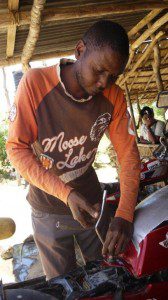Koert Lindijer has been a correspondent in Africa for the Dutch newspaper NRC since 1983. He is the author of four books on African affairs.

Mopeds serve as public transport. “With a moped young people can earn two euro’s per day,” says Hamisi. “There is no other work here. The government in Nairobi does nothing for us. Why would I still vote? We young people do not talk about elections anymore; we don’t belong to Kenya anyway. On the coast an election means fight and die. ”
Trouble is brewing in the Kenyan coast. In August, fighting broke out between nomads and farmers in the delta of the River Tana. There were over a hundred deaths, including women and children, killed by knife and spear wounds.
Then followed three days of riots in Mombasa after the assassination of the radical Islamic preacher Aboud Rogo, who had called on young people to fight for the Somali terrorist group Al-Shabaab. After the murder his followers attacked the police and killed a cop.
The situation became even more violent when, according to the police, another group, the Mombasa Republican Council (MRC), attacked a police station and a political meeting. The MRC demands independence for the coastal region and is according to unconfirmed reports training in camps to prepare for a liberation struggle. In October, police arrested the leader of the MRC, Omar Mwamnuadzi, in a village near Mombasa. Dozens of young people with machetes and sticks tried to prevent the arrest and were arrested. Two were shot. Mwamnuadzi was released on bail one month later.
Khelef Khalifa is head of Muhuri, a group in Mombasa that defends the rights of Muslims. “Kenya is not stable,” he says, “because there is so much corruption and impunity”. He blames politicians who joined the campaign for the March elections as tribal warlords. “I am terrified of what is to come.”
Najib Balala, ex-mayor of Mombasa and until recently a minister in Kenya’s capital Nairobi, warns of the growing support fir Al-Shabaab and the MRC. “We coastal residents have been marginalized. Therefore we sometimes think that we do not belong to Kenya and we support the ideals of the MRC. ”
The invasion by the Kenyan army in Somalia last year and the recent capture of the city of Kismayo threw oil on the fire. “Since the capture of Kismayo Kenyan Al-Shabaab fighters are turning back. They shave their beards off and prepare for attacks in Mombasa.”
The residents on the coast explain their disadvantaged position out of historical injustice. Their sight was for centuries focused on the sea, for they were cut off from the natives by a wide strip of dry and merciless land. Arab and Persian traders settled with the inhabitants of the coast and spread Islam. About 25 percent of Kenyans are Muslim and the majority of them live on the coast and the adjacent Northeast province.
After Arab domination coastal lands were assigned to British settlers. And after independence in 1964, the coastal population was exploited by the natives. Under the rule of Kenya’s first president Jomo Kenyatta inland tribes flooded to the coast and got most jobs in the tourist industry and the harbor.
Half of the residents of Mombasa originate now from the interior. They own more land than the coastal population. Four of the six districts on the coast are among the poorest districts in Kenya. The coastal population feels colonized by compatriots.
On a dry plain near the village of Kinango all trees have been felled for charcoal. Unemployed young people are squatting in a half build school. “Few children go to school,” says Mumbo Munga (25). And what does the government do? Mumba and his friends laugh derisively. “The government always leaves us in the lurch,” said Nzole Tsuma.
The frustration among the youth feeds the MRC. “No one ever listened to us”, fulminates one. “We will join and fight with the MRC,” says the other. “We are fighting for a separate state. South Sudan also got it’s independence. It is better to suffer in war than to suffer forever. ”
The contrast between the luxury hotels on the coast for the merging Kenyan middleclass and the Western tourists on the one hand and the poor villages on the other is distressing. Young coastal people do not even own a small field and live in leaky straw huts or sprawling slums. MRC and Al-Shabaab have different purposes but draw from the same anger.
Isaac Rumba Mbui leads the youth wing of the MRC. “Despair is the main reason why the MRC was founded,” he explains. “We demand our own state Pwani, an area of at least 15 kilometers wide. And we are calling for a boycott of the elections. These elections are for Kenya, not for us.”
The call for afternoon prayers form the minaret of the Great Mosque of Mombasa rises above the noise of the motorized rickshaws. Steps away in the great cathedral sounds the serene singing of a girl choir. Until recently, there were hardly religious tensions in Kenya, but after the assassination of the Islamic preacher Aboud Rogo churches were attacked. “Kenya is at war,” says Marcelino Waithaka Thuku of the Human Rights Commission of the Catholic Church. “After the invasion by Kenya in Somalia, Al-Shabaab declared war on Kenya. And where better to hit Kenya than on the coast, with its religiously mixed population in an area where the population has historically felt subordinated.”
Waithaika hopes that a religious war between Christians and Muslims can be avoided, that the traditional tolerance will win from the fueled hatred. “Muslim Radicals benefit from an inter-religious conflict,” he says. An attack on the cathedral was recently discovered in time. At the entrance, churchgoers are now searched with a metal detector. “It is absurd in a house of God,” says Waithaka. “That’s the price when you fight against extremists.”
Mixture of Arabs, blacks and Indians

The population of the Kenyan coast is a unique mix of Arabs, indigenous tribes, whites, Indians and people of the Kenyan interior. The coastal people do agree on one thing: they have been marginalized in Kenya. But the opposition is divided: radical Muslims want Islamic law implemented and support Al-Shabaab. The MRC is not religious.

